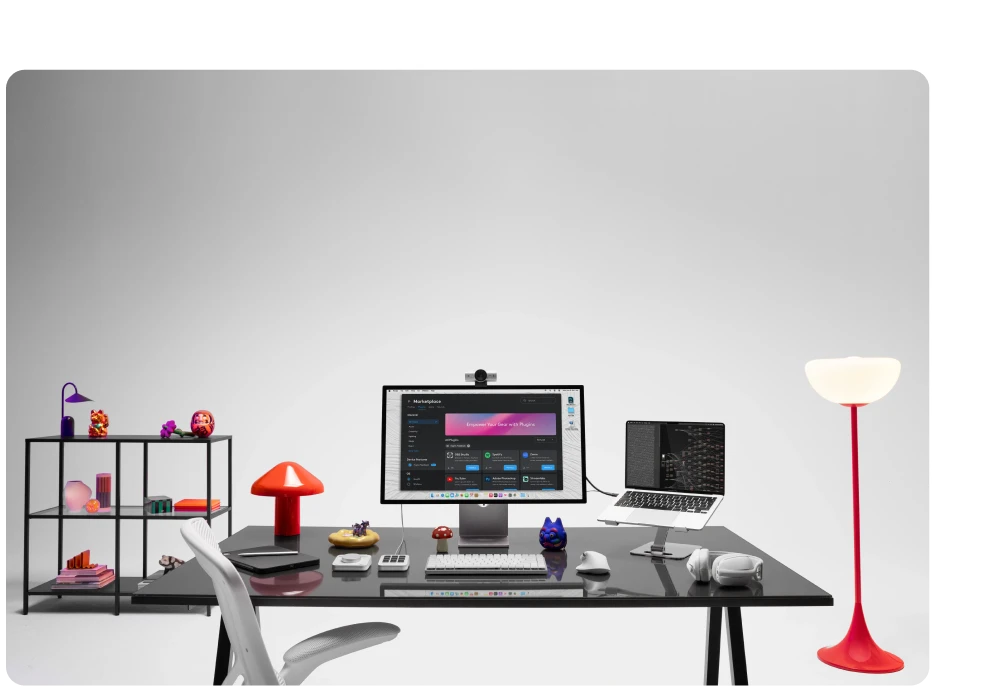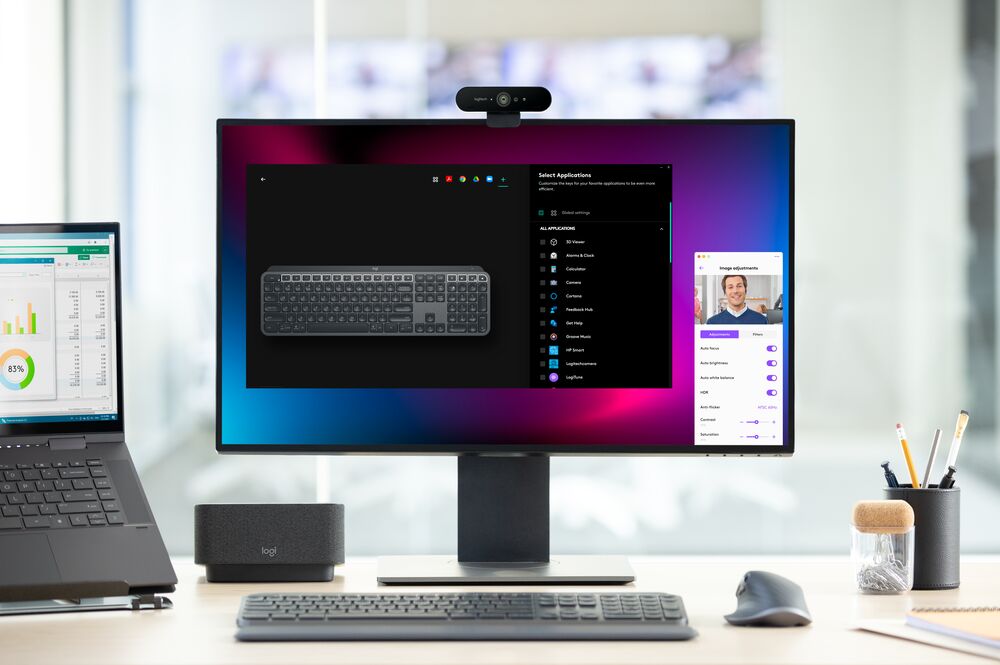Supporting Logitech’s marketing strategy with better feed management
How Feedonomics helped increase data visibility, reduce errors, and improve paid media performance

Customer challenges
- Addressing product feed errors with poor visibility and control
- Managing manual, time-consuming feed updates across multiple locales and platforms
- Struggling to support paid media campaigns and new channels without segmented, optimized product data
Feedonomics solutions
- Provide a transparent, self-service platform with real-time feed diagnostics and proactive alerts
- Automate feed syndication and localization across 10 global locales and third-party platforms
- Enable product data segmentation, content optimization, and support for new ad channels like TikTok and Reddit

Location: San Jose, California
Industry: Electronics
Company type: Brand manufacturer
Website: logitech.com
Meaningful results
Reduced product data errors from over 5% to less than 1%
Saved 30+ hours per month through automation of feed updates and syndication
Increased Google Shopping organic clicks by 25% year over year
 Logitech is a Swiss technology company with its main headquarters in Lausanne, Switzerland, and a U.S. headquarters in San Jose, California. It is globally recognized for designing personal peripherals such as mice and keyboards, gaming gear, video collaboration tools, and software, sold under brands like Logitech, Logitech G, and Mevo. The company is focused on delivering a seamless ecommerce experience across its own site and third-party platforms.
Logitech is a Swiss technology company with its main headquarters in Lausanne, Switzerland, and a U.S. headquarters in San Jose, California. It is globally recognized for designing personal peripherals such as mice and keyboards, gaming gear, video collaboration tools, and software, sold under brands like Logitech, Logitech G, and Mevo. The company is focused on delivering a seamless ecommerce experience across its own site and third-party platforms.
Product data plays a central role in that effort. It powers paid media campaigns on Google, Meta, TikTok, and other platforms, drives SEO-optimized landing pages and product configurators, and ensures accurate listings across languages, regions, and marketplaces. Keeping that data consistent and up to date is essential for visibility, performance, and conversion.
Logitech’s previous feed solution lacked transparency, offered no direct access to feed data, and couldn’t scale with the company’s growing needs. Errors were hard to diagnose, slow to fix, and often repeated—impacting performance and delaying campaign launches. As Logitech aimed to expand its ecommerce operations, managing product feeds across multiple teams, partners, and countries became a major challenge.
The company selected Feedonomics to address data visibility issues, and ultimately discovered a lot more that could be done with a robust feed management solution. It now sends product feeds to Google, Meta, TikTok, Pinterest, Reddit, Optiversal, Zoovu, Bazaarvoice, and Impact.
Trung Tran, Digital Product Manager at Logitech, works across internal teams and external vendors to enhance logitech.com with features that drive traffic and increase revenue. Erin Norton, Head of Media and Digital, oversees media operations, advertising platforms, and paid campaigns. Both see Feedonomics as the solution that has given them more control, greater efficiency, and the ability to scale their strategy across global markets.
“Feedonomics has been a transformative partner for us,” said Tran. “We saw how we can expand and scale and use our product data more efficiently and more effectively. Now, feeds are a core part of our business, whereas before they were an afterthought.”

“Feedonomics has been a transformative partner for us. We saw how we can expand and scale and use our product data more efficiently and more effectively. Now, feeds are a core part of our business.”
Trung Tran,
 Gaining control with better visibility
Gaining control with better visibility
Before moving to Feedonomics, Logitech relied on a legacy feed vendor that gave the company little control or visibility into how product data was managed. The process for resolving feed issues was slow and manual, often requiring back-and-forth with external support teams just to view or troubleshoot the data.
“It was a black box,” Tran said. “If we wanted to see the feed, we’d have to ask them and they’d send us an export.”
That lack of access made it difficult to identify or fix recurring issues—even those that originated upstream in Logitech’s source data. Without insight into how feeds were structured or where problems were occurring, teams were stuck waiting for external partners to investigate and respond. Errors could linger for weeks and frequently resurfaced.
This also created complications when working with multiple agencies. Because the previous vendor fully owned the platform, Logitech couldn’t grant access to other partners when needed. This limited collaboration and made it harder to support campaigns that spanned different regions or media strategies.
Feedonomics changed that by giving Logitech direct access to a transparent, user-friendly platform. Now, teams can log in, review product data in real time, export feeds, and investigate errors. Proactive alerts flag issues early, and detailed SKU-level reporting makes it easier to trace problems back to their source.
Logitech also works with a dedicated Feedonomics team that helps monitor listings, resolve issues, and improve data quality across platforms. Norton noted how much value this hands-on support provides.
“I really appreciate the amount of transparency and communication that we get from Feedonomics, including regular meetings and a support team that is always very responsive and easy to work with,” Norton said. “Feedonomics has been very knowledgeable about all the different platforms we are implementing on. So I also very much trust the responses I’m getting back and the help that I’m receiving.”

“I really appreciate the amount of transparency and communication that we get from Feedonomics, including regular meetings and a support team that is always very responsive and easy to work with.”
Erin Norton,
 Enabling scale and performance across paid media channels
Enabling scale and performance across paid media channels
Behind the scenes, Feedonomics supports a vast and complex catalog. Logitech runs over 22 databases with feeds in 10 locales. SKU counts range from a few hundred to over 7,000 per locale. Many products are duplicated across regions, with localized pricing and descriptions.
Before Feedonomics, inconsistent data and limited segmentation made it difficult to fully leverage product-based advertising formats. The team also lacked the agility to test campaigns, promote specific product groups, or easily expand to social platforms like TikTok, Reddit, and Pinterest.
With Feedonomics, Logitech gained the ability to organize and segment product data using custom labels, enabling more precise targeting across channels. Norton emphasized how this flexibility made it easier to support both high-volume campaigns and more niche segments, including new product launches, refurbished items, and to identify B2B or B2C product groups.
“We’re definitely seeing improvements in terms of how we run campaigns and manage them,” Tran said. “There’s less time spent on fixing product data, and more time just running the campaigns, optimizing and analyzing the data, and coming up with a strategy.”

“We're definitely seeing improvements in terms of how we run campaigns and manage them. There's less time spent on fixing product data, and more time just running the campaigns, optimizing and analyzing the data, and coming up with a strategy.”
Trung Tran,
As Logitech’s paid media strategy evolved, it became clear that product feed quality directly impacted campaign effectiveness—especially on performance-driven platforms like Google and Meta.
“Our product data is not as consistent or as optimized as we would like it to be. So we’re leveraging Feedonomics to help us rewrite a lot of the product titles before they’re getting fed to the different marketing platforms,” Tran said.
Norton highlighted the critical role product data now plays in paid media—and how Feedonomics makes it possible to fully leverage catalog-based campaigns.
“We have been able to actually scale up and expand our presence on paid media using those catalogs,” Norton said. “So on Google and Meta especially, which were already our two biggest platforms for digital media, we’re able to actually lean in a bit harder to product-based campaigns like Performance Max that rely on those data feeds, and have the confidence that the data that we have in there is accurate.”
Laying the groundwork for optimization and personalization
As part of its long-term strategy, Logitech is investing in tools and technologies that support personalized customer journeys and better product discovery. A core focus is optimizing how product data is delivered and displayed—not just for advertising, but across the full ecommerce experience.
Using Feedonomics, Logitech syndicates product data to power personalized tools like Zoovu, a product configurator embedded on logitech.com. This tool helps users discover the right combination of products based on specific attributes like ergonomics or mobility.
“We’re sending product data to Zoovu so it has the latest information on pricing and what products are available,” Tran said. “Basically, a user would use the platform or use the tool to find a set of products that would suit their workspace.”
The company also partners with Optiversal, which uses product data from Feedonomics to create dynamic SEO-optimized landing pages. As products are added, removed, or repriced, feeds automatically update these pages in real time—reducing manual work while improving discoverability.
At the same time, Logitech is beginning to explore AI-assisted optimizations. The team is testing how Feedonomics can help rewrite optimize titles and improve keyword structure, and it’s monitoring product visibility in AI search platforms like ChatGPT and Perplexity. Future plans include A/B testing different feed structures and integrating feeds more tightly with CRM and CDP platforms to drive personalized email and SMS campaigns.
 Driving results and preparing for global expansion
Driving results and preparing for global expansion
Since implementing Feedonomics, Logitech has seen measurable improvements in efficiency, data quality, and campaign performance. Product data issues—once a persistent problem—have dropped significantly.
“Before we started with Feedonomics, way more than 5% of our product data had issues, and I want to say that it’s probably gone down to less than 1% now,” Tran said.
Feed automation now saves the team dozens of hours each month, freeing up time for higher-value strategic work.
“I know that if I was to be managing Optiversal and Bazaarvoice, it would probably take me 30 hours each month to manage all those feeds for all those locales, but we’ve got it automated so I don’t have to really touch them each month anymore,” Tran said.

“It would probably take me 30 hours each month to manage all those feeds for all those locales, but we've got it automated so I don't have to really touch them each month anymore.”
Trung Tran,
Logitech has also seen gains in traffic and engagement. According to Tran, the company experienced a 25% year-over-year increase in Google Shopping organic clicks and a 15% lift in consumer interest for the electronics category—results the team attributes in part to better product data and more consistent feed execution.
Norton said feed-based marketing has become a major part of go-to-market planning, thanks to more reliable and efficient data management.
“We have some products launching next month, and I’ve already been contacted to make sure that we can have those products in the feed as soon as possible because they’ll be leveraged in paid media essentially the same day,” Norton said.
With Feedonomics fully integrated into its operations, Logitech is now planning for broader expansion. The company currently supports 10 ecommerce locales through Feedonomics but operates in more than 20 markets globally. Expanding feed coverage, optimizing data structure for new platforms, and deepening integration with AI tools and CDPs are all priorities for the next phase.
For Logitech, Feedonomics has gone from being a backend utility to a strategic enabler across ecommerce, marketing, and product discovery.
“We’re always looking at how we can leverage it more, how we can take the workload off our dev teams, and use Feedonomics to really transform the data and get it into the format that we need,” Tran said.


